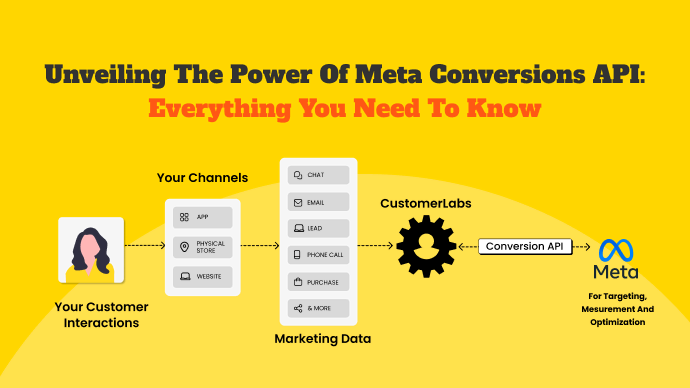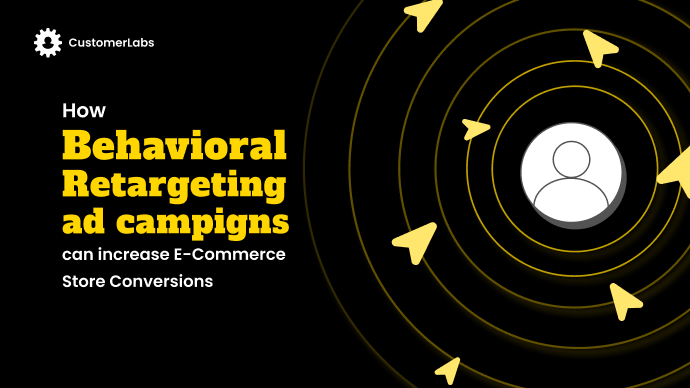The buzzing term among all businesses after the emergence of data-privacy regulations across the world is ‘First-party data,’ or ‘1PD.’ Every industry, offline or online, is shifting its focus to first-party data for various reasons, primarily because it gives information about the customer directly.
In this blog, we will comprehensively cover
- What is first-party data, and why does it matter?
- Comparison of first-party, second-party, third-party, and zero-party data
- The importance of first-party data in marketing
- How to collect first-party data
- How to segment first-party data
- Using first-party data effectively for
- Google Ads, including Performance Max Campaigns
- Meta Ads, also for Meta Advantage+ Campaigns
- Use cases of First-party data
- Benefits of first-party data
Let us dive in to know everything from scratch one by one and get a detailed view of the A to Z of first-party data, a cue card for the cookieless world to offer personalization to your users and prospective customers!
What is First-party Data?
The simple definition: First-party data is the data collected by the businesses from their users directly, both online and offline. It can be a username, email address, phone number, answers to a survey or a poll, etc.
But it is just not limited to that, says Google, in its First party data activation playbook by ThinkWithGoogle.
It says, “Business data is also first-party data.”
According to that statement, First-party data comprises the following data collected by businesses themselves:
- Demographic data
- Location
- User purchase data
- Personal data such as name, email, IP address, contact number, social media handles, etc. (Social Media Conversations & CRMs)
- Consumer feedback & interest through surveys and other forms
- User behavior on your website, app, or product
And it comprises the following data of the businesses:
- Business goal
- Profit
- Revenue
- Conversion Data
- Store location data
- Margin
- Stock level
Now let’s look at the other data types and compare them with first-party data. By the end of the comparison, we’ll be able to weigh out a winner.
Read on First Party Data strategy for B2B Brands

Comparison: First-party data Vs Second party data Vs Third party data Vs Zero party data
Let’s initially start with their definitions of the other types of data and then compare them with first-party data.
Zero-party data:
If a customer proactively shares their data about their personal preferences, tastes, likes & dislikes with a business, that data is called zero-party data.
Second-party data:
If the data is exchanged between two businesses in a similar niche through a partnership, it is called second-party data.
Third-party data:
The data collected by the data aggregators and sold to other businesses is the third-party data.
Note: Both second-party data and third-party data are collected in a manner where the customer might or might not be aware or informed of the data being shared or sold among businesses.
If you want to dig a little deeper on First-Party Data Vs Second-Party Data Vs Third-Party Data
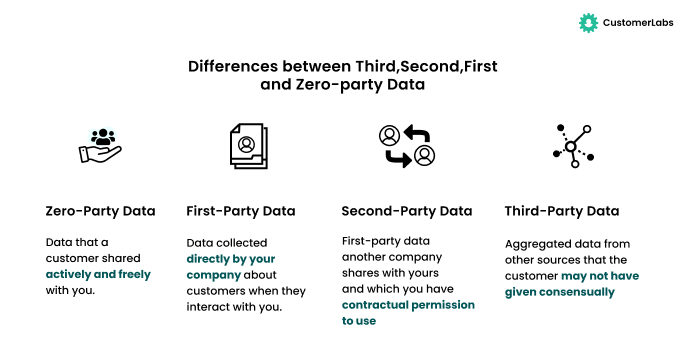
An easy comparison: First-Party Data Vs Second-Party Data Vs Third-Party Data
| Attribute | Zero-Party Data | First-Party Data | Second-Party Data | Third-Party Data |
| Definition | Information customers willingly and proactively share. | Data collected directly from customer interactions. | Another company’s first-party data shared via partnership. | Data collected by external aggregators, not directly from the customer. |
| Source / Collection Method | Forms, surveys, preference centers, quizzes. | Website visits, app usage, CRM, purchase history, and email sign-ups. | Loyalty program partnerships, co-branded campaigns. | Cookies, data brokers, purchased lists. |
| Ownership & Control | Brand fully owned with explicit consent. | Brand owns and controls. | Shared ownership depends on agreement. | External providers own it; brands license usage. |
| Accuracy / Reliability | Very high (user-given). | High (direct, contextual). | Moderate to high (trusted partner source). | Low to moderate (less relevant, often outdated). |
| Examples | A shopper selects preferred product categories in a quiz. | E-commerce site tracking purchases and email behavior. | Airline sharing frequent flyer data with a hotel chain. | A purchased demographic list from a data broker. |
| Challenges | Limited scale depends on customer engagement. | Requires strong systems for storage, consent, and activation. | Limited access, compliance hurdles, trust dependency. | Privacy concerns, low accuracy, disappearing in a cookieless world. |
| Privacy & Compliance | Fully compliant (opt-in, explicit consent). | Full compliance if collected with consent; GDPR/CCPA friendly. | Compliance depends on partner contracts and transparency. | High risk; often non-compliant with GDPR/CCPA; being phased out. |
From the comparison, it is clear that the winner is first-party data (which is kind of Zero party data)
Why?
Because you are directly collecting it from your users with proper consent, which makes you stay compliant with the privacy laws.
But all you need is the right setup in place.
Let’s talk more in detail about it as we move forward. Now let’s look at its importance.
Why is First-party data Important in marketing?
If you ask me why, I will say for three reasons:
- It is your own user data; hence, it’s accurate and independent (no brokers required)
- You collect it with consent, so your data is compliant
- It’s not just me who says it is important; even Meta and Google say the same. (A good reason to believe, right?)
Now let me elaborate on the importance of first-party data a bit.
In the beginning, the data was collected by third-party browser cookies and pixels of numerous ad platforms, such as Meta, Google, etc.
After the release of various data privacy updates, including Apple’s iOS 14+, it became difficult for ad platforms like Google and Meta to effectively collect the data and store it to run ad campaigns. Hence, faced audience signal loss.
All these led to the decline of ad campaign performance beyond anyone’s imagination, causing doldrums in the hearts of marketers.
So privacy compliance became a necessity to keep up with the better ad performance.
Therefore, it is high time that you realize the importance of first-party data and start collecting it now.
Also learn how first-party data can help hospitality industry
You don’t take my word for it? It’s totally fine. See what the big sharks say about it.
What does Sharks, like Google says About First-party data?
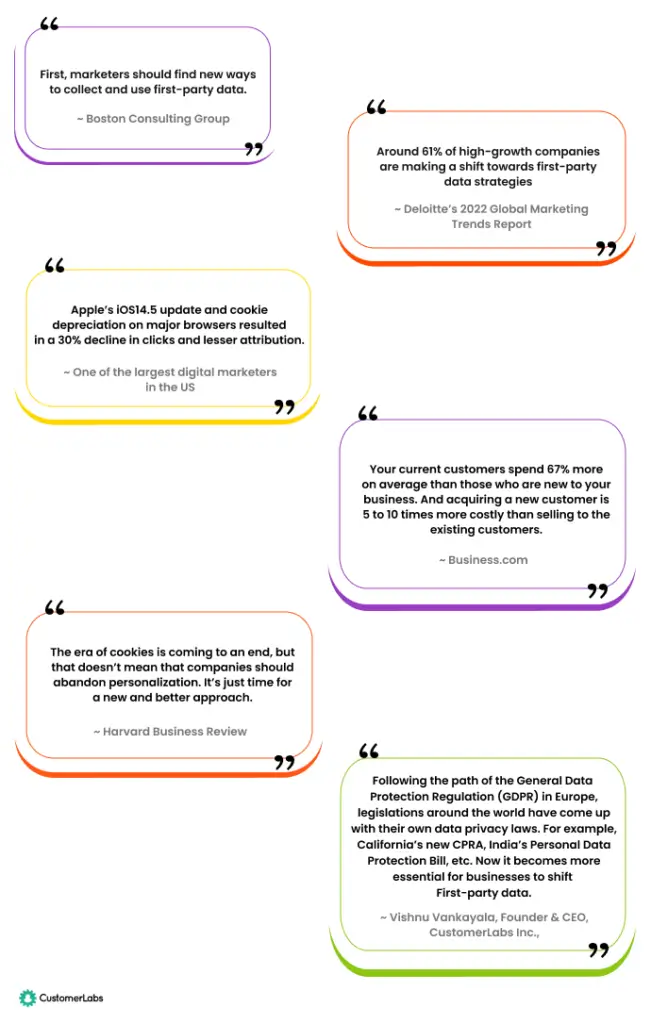
According to a Think with Google APAC study, first-party data helps brands hit a sweet spot in today’s “Messy Middle” of consumer decision-making: using consented customer data + behavioural science + relevant messaging helps build preference and meet privacy expectations

Google has reiterated by saying, “Leverage audience signals from your first-party data to reach similar audiences and run your ad campaigns effectively.”
The report published on November 21, 2024 by Shopify titled “Seeing Around Corners: Personalization” reinforces the idea of first-party data being the future of advertising.
Why it’s all about first-party data now: not just because of the compliance but also the money (benefits) that it brings to the businesses. Before jumping right into it, let’s understand the intricacies of first-party data.
Notice the image down below? That is the full funnel of first-party data; take a good look at it. I’m going to get back to it by the end of the blog.
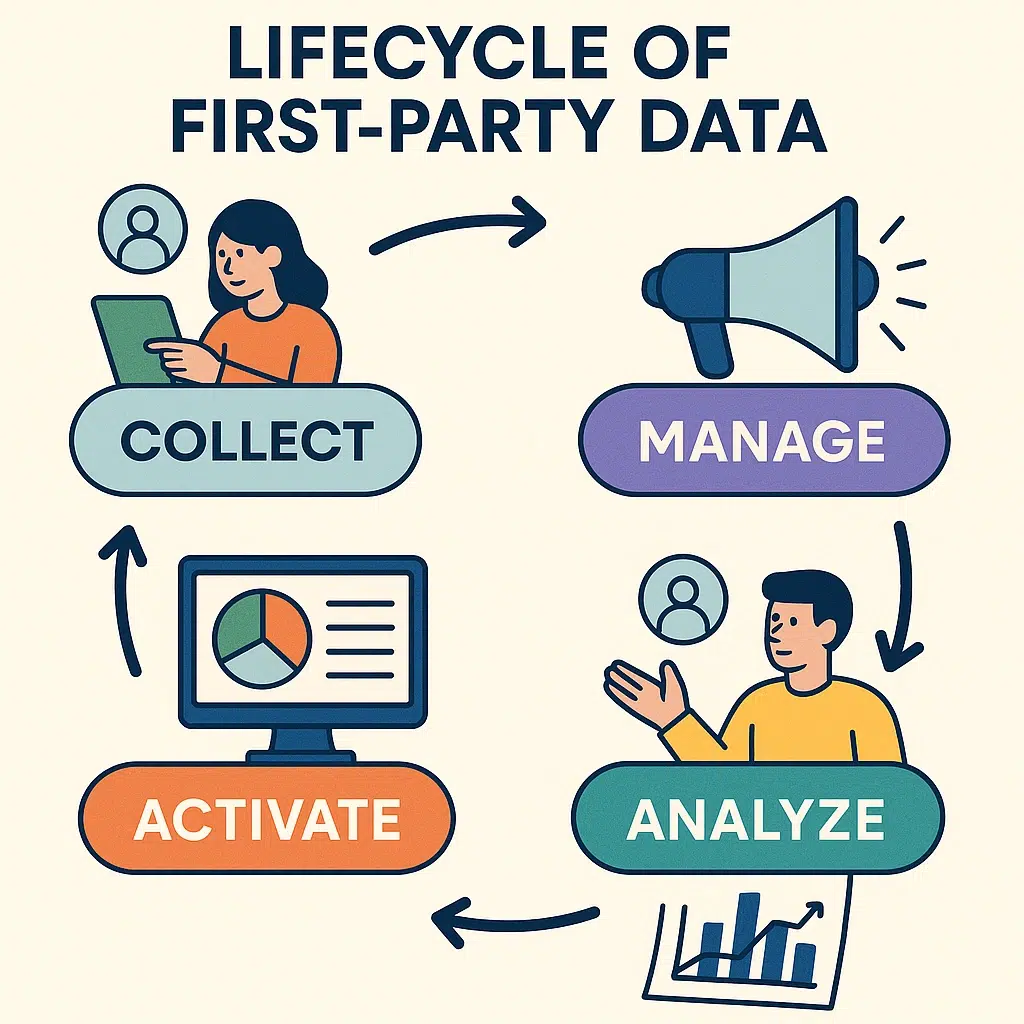
What is the Source of First-party Data?
In the current era, you can see that every user interacts with a single business through various touchpoints on both online and offline platforms.
A customer’s journey is not at all linear. It is a web of complex behaviors. Only when a business understands all of this and offers a smooth, personalized experience does a user become a customer.
So below are the places where you can collect the first-party data:
1. Website:
Your website is the primary source of all first-party data or the 1PD that you can rely on. From user behavior and actions to IP address, email address and phone number, you can collect all the data when a user lands on your website. Also, you can still track and activate your anonymous visitors.
2. Mobile Web:
The mobile web is similar to the website and allows you to collect all the first-party data. However, with iOS 14+ and Android 14 updates, it is difficult to collect users’ behavioral data on the mobile web. And to overcome this problem, you can use effective tools like 1PD Ops, which collects the data on the server side.
3. Apps:
A mobile app offers more data parameters, such as an email address, phone number, etc., as you can have the users logged in to the app to use it.
And it is seen that the probability of a user logging into an app is higher compared to the user logging on to a website. Therefore, if you have an app, you are most likely to get complete customer data without much effort and it is your own data that stays with you forever!
4. Email, SMS & Messaging Platforms:
Email marketing dates back to the first phase of digital marketing, where you get to know who is opening your emails, and who has shown interest in the email you sent. Now you have customer behavioral data and how they interact with your brand, which is again first-party data.
With WhatsApp API out, many marketers have shifted their focus to collecting data even from WhatsApp interactions. This gives you better first-party data behavior.
Text messaging service is a pivotal tool for collecting first-party data, as it allows businesses to directly engage with customers, track their interactions, and gather valuable insights into their preferences and behaviors.
5. Point of Sale (PoS):
This is an offline source, as it is the data you can collect at the point of sale of your retail store.
It gives information on how a certain user interacts with your brand offline, their feedback on your service, product, etc.
This data is precious and you should harness it quickly, as you know what a user is interested in buying, what they are not, and where they are buying from. No other company has this unique data that you get from your customer directly.
Pro Tip: Using offline conversion tracking, you can sync this data to ad platforms.
6. Customer Support Center:
This is where you not just get to know about the happy customers but also their problems.
Now, if you collect this data from the support center, you can easily understand the user behavior and enhance their experience to help them make better decisions. This can be the perfect source to add to the existing customer behavior data you have gained through all the other above sources.
Now you know the sources where you can collect the data; let’s dig and understand the ways you can collect it.
How to Collect First-party Data?
There are multiple ways to collect 1PD or first-party data both offline and online.
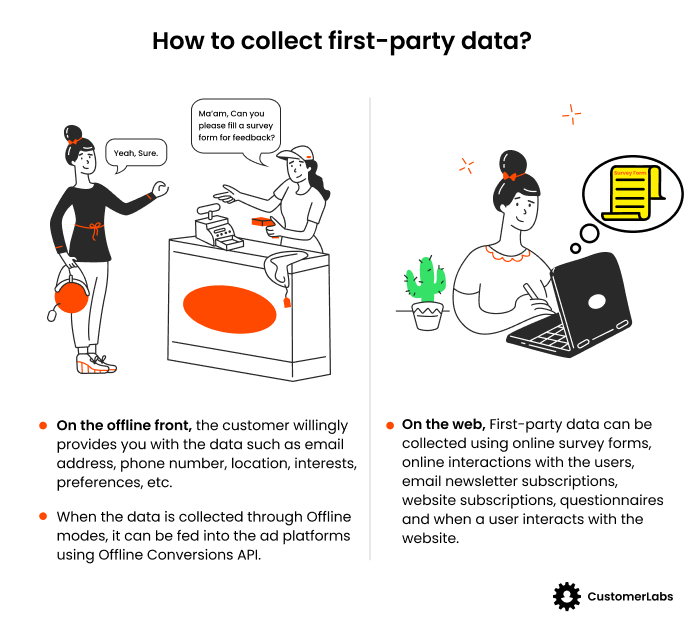
- Website & App Tracking
- Track on-site behavior: page views, clicks, add-to-cart, and purchases.
- Use server-side tracking for accuracy in a cookieless world.
- Forms & Lead Magnets
- Newsletter sign-ups, gated content, and free trials.
- Keep forms short & value-driven (give something in exchange).
- Surveys & Quizzes (Zero-Party Crossover)
- Collect preferences, feedback, and intent directly from users.
- Example: “Find your perfect product” quiz on an e-commerce site.
- Loyalty & Rewards Programs
- Incentivize customers to share info by offering points, discounts, or exclusive access.
- Helps build rich purchase history data.
- Email & SMS Engagement
- Track open rates, click-throughs, and replies.
- Segment customers based on engagement.
- Customer Accounts & Profiles
- Encourage users to create accounts (vs. guest checkout).
- Build long-term profiles with purchase history and preferences.
- Point-of-Sale (POS) & Offline Data
- Collect purchase info from physical stores or events.
- Sync offline data with online systems for a unified view.
- Customer Support Interactions
- Chat transcripts, support tickets, and feedback forms.
- Adds qualitative context to quantitative data.
- Social Media & Community Engagement
- Gather data via polls, comments, and direct interactions.
- Works well when tied back to CRM.
- Connected Tools & Integrations
- Pull 1P data from CRMs, helpdesks, or email platforms into a CDP.
- Centralizes and activates data for campaigns.
Pro Tip: First-party data is incomplete without your anonymous website user behavior turn them into real customers using a real-time 1PD Ops Platform (1PD Ops).

Collection is done. Next up is Unification. Merge them all.
How to Unify First-Party Data
If you think about “why I should unify my first-party data sources?” look at the BCG’s global digital marketing maturity survey, companies that connected all their first-party data sources generated double the incremental revenue from a single ad placement, communication or outreach.

Let’s understand how to unify 1PD?
- Break Down Data Silos
- Customer data often sits in multiple places: website analytics, CRM, email tools, POS, and ads manager.
- Start by mapping out all touchpoints where data is stored.
- Use a Central Hub (1PD Ops Layer)
- Bring data together into a central platform (CustomerLabs, CRM, or a data pipeline).
- Ensure real-time sync across tools to avoid gaps.
- Identity Resolution
- Match identifiers like email, phone number, device ID, or login across sources.
- Deduplicate records so one person doesn’t look like five.
- Standardize & Clean Data
- Normalize formats (e.g., phone numbers, country codes).
- Remove incomplete, duplicate, or outdated records.
- Ensure Privacy & Consent Tracking
- Carry over user consent flags from the collection stage.
- Ensure all unified data respects GDPR/CCPA rules.
- Create a Single Customer View (SCV)
- Combine interactions from online and offline channels into one profile.
- Example: A single profile showing purchase history + email engagement + website visits.
How to Segment First-Party data?
Here’s the answer even before you think why.
A ResearchGate publication stresses that customer segmentation is vital for business success. It helps allocate resources effectively, boost marketing efficiency, and increase loyalty.
By targeting relevant groups, companies gain more sales opportunities and reduce wasted spend.

Let’s understand how to segment first-party data
- Demographic Segmentation
- Group users by age, gender, income, occupation, or location.
- Example: Target high-income users in New York with premium product ads.
- Behavioral Segmentation
- Segment based on on-site or in-app actions: page visits, clicks, purchases, cart abandons.
- Example: Retarget users who browsed but didn’t buy.
- Transactional Segmentation
- Use purchase history, order frequency, and average order value (AOV).
- Example: Create VIP segments for repeat, high-value customers.
- Engagement Segmentation
- Divide users by how they interact with your brand: email opens, SMS clicks, push notifications, or social engagement.
- Example: Re-engage inactive email subscribers with a win-back campaign.
- Lifecycle Stage Segmentation
- Segment users as new leads, first-time buyers, repeat customers, or churn risk.
- Example: Nurture new leads with education campaigns, while upselling repeat customers.
- Intent & Preference Segmentation (Zero-Party Crossover)
- Use survey, quiz, or preference center data to build intent-based segments.
- Example: If a customer selects “interested in skincare,” only send them relevant product offers.
- Technographic / Device Segmentation
- Segment by device type, operating system, or channel preference.
- Example: Push mobile app offers only to Android/iOS users.
How to Leverage First-party data (1PD): 1P data Activation?
- Ad Platform Integrations
- Push segments into Meta Ads, Google Ads, TikTok, or LinkedIn.
- Example: Retarget cart abandoners with Meta Advantage+ campaigns.
- Personalized Email & SMS Campaigns
- Use customer preferences, purchase history, and engagement behavior.
- Example: Send a discount code to dormant customers who haven’t purchased in 90 days.
- On-Site / In-App Personalization
- Dynamically change banners, product recommendations, or landing pages based on user profile.
- Example: Show returning customers “Welcome back” with curated recommendations.
- CRM & Sales Enablement
- Equip sales teams with unified customer profiles.
- Example: Sales reps know a lead’s browsing history and recent downloads before a call.
- Lookalike & Predictive Audiences
- Feed high-value customer data into ad platforms to build lookalike audiences.
- Example: Use your top 10% spenders to find similar audiences on Meta.
- Cross-Channel Consistency
- Sync audiences across email, ads, push notifications, and offline campaigns.
- Example: A customer who buys online is excluded from ongoing “acquisition” campaigns.
- Customer Retention & Loyalty
- Trigger loyalty program rewards or win-back offers.
- Example: After 3 purchases, automatically move a customer into your VIP loyalty tier.
Read how to increase customer retention using first-party data
- Measurement & Feedback Loops
- Track how activated audiences perform: ROAS, CTR, and churn rate.
- Feed performance data back into your 1PD Ops for smarter next cycles.
Now we have covered the full funnel of first-party data. Let’s talk about something about how first-party data and ad campaigns go hand in hand.
Evolution of AI and Ad campaigns
After the evolution of AI, the mechanism of ads and how they work has completely changed. All you need to do is feed good data and watch the magic happen. But sadly, most marketers feel like they have lost control once AI became the name of the game.
All I’m saying is that it doesn’t have to be that way.
Here comes the philosophy of the day: Control what you can. I mean, your data.
When you feed in the right data. The ad algorithm can pick up the right signals; that is the only thing that matters to your businesses. Now, you can tell your ad campaigns which data is important and which is not.
Basically, you can order the ad platforms with data. That is your magical wand.
Magic can never happen without a proper wand (data).
How Does First-party Data Help Improve Google Ads Performance?
The Performance Max campaigns launched by Google recently clearly state that you should feed its algorithm with as much data as possible. This proves to be a step towards embracing first-party data.
Google Seeks More First-party data…
Google’s ad platform seeks high-quality audience signals (first-party data) to help its algorithm learn about your users’ behavior and then retarget audiences based on that data. The more data, the better the ad campaign performance. First-party data helps Google’s Ad Platform increase its Customer Match Rate.
Also read on Google Retargeting with First-party Data
We did an Experiment Using First-Party data in Google Ads
We tried an experiment with Google ads by sending first-party, second party and third-party data.
The one where we used first-party data came up with pretty impressive results.
For anonymous users, Google gave us a match rate of around 50 to 60%, which is really great. Because the average match rate for most marketers is between 29 and 50%

And for the known users, Google was able to give us a 100% match rate.
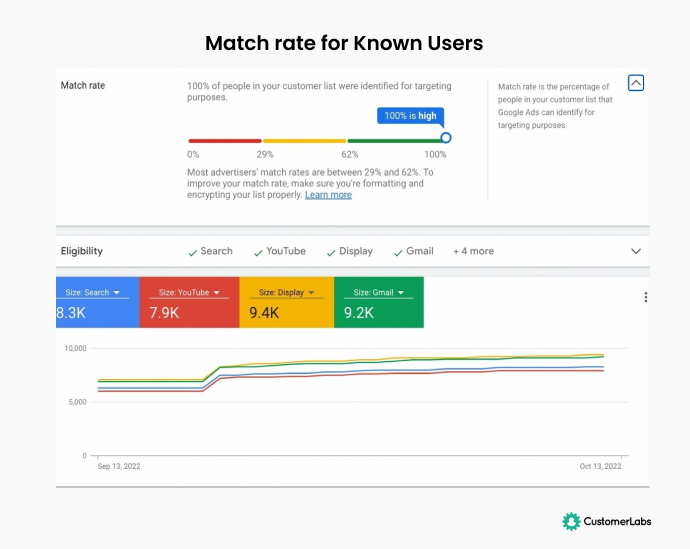
Now that’s the power of First-party data when used right.
Google’s Updates that emphasise on the importance of first-party data
Update 1: Building Privacy-Centric Ad Strategies
Google emphasized that first-party data (1PD) is foundational to building privacy-centric ad strategies in the cookieless world. It also highlighted its dual advantage: it’s both privacy-aligned (consented, owned) and powerful when combined with machine learning, enabling tailored, high-performing campaigns.
Update 2: Privacy First with Confidential Matching
Google launched Confidential Matching in September 2024. It leverages confidential computing to encrypt and protect first-party data during audience matching and measurement.
This means advertisers can securely use their data—without Google or external parties having access to the raw information. It’s a built-in, privacy-first approach rolled out at no additional cost.
Update 3: Simplifying First-Party Data Management
Google introduced Google Ads Data Manager in October 2023 to make it easier for advertisers to connect, manage, and use first-party data seamlessly. This tool consolidates data connections—like enhanced conversions for leads and Customer Match—into a single interface, reducing reliance on engineering efforts and accelerating time-to-value. Early adopters saw a 43% increase in qualified leads
And the list goes on and on, from the changes to discontinue Similar Audiences Targeting announced on May 1, 2023, to Google’s consent mode V2 and Demand Gen Campaigns to leverage lookalike audiences.
One platform down. Now let’s look at Meta with First-party data.
How Does First-party Data Help With Meta Ads?
Meta Network consists of Facebook, Instagram, WhatsApp, Messenger, and Audience Network, and every person has a dire necessity to use these applications.
Meta’s ad algorithms are updated and they are totally powered by AI now. In one of the recent talks by Mark Zuckerberg, the founder & CEO of Meta, he says,
“Over the long term, advertisers will basically just be able to tell us a business objective and a budget, and we’re going to go do the rest for them. We’re going to get there incrementally over time, but I think this is going to be a very big deal.”
This clearly says where Meta is heading towards – complete automation. But for this to be realized, Meta needs your data; high-quality first-party data (1PD) to train these ad algorithms.
Also read on Why you should optimize Meta Ads with First-Party Data
Evolution of Meta’s Algorithms
Meta’s ad algorithm has evolved from just counting clicks or purchases to reading the full journey.
Instead of treating every action the same, it now looks at the sequence of events like viewing a product, adding it to a cart, and then buying.
By sending richer signals (e.g. “high-value purchase” or “repeat buyer”), you can help Meta spot the most valuable users and optimize campaigns around them.
For example, imagine two users visit a shoe store. One just views a product and leaves; the other views → adds to cart → buys → buys again.
With signal engineering, Meta learns the second user is more valuable and finds more people like them.
Another Experiment: Using First-Party data on Meta Ads
We tried an experiment with Meta ads by sending in the first-party data of 16000 blog visitors to Meta. And Meta was able to match more than 80% of the users. Whereas with the pixel-collected data, Meta gave us a match rate of around 25%.
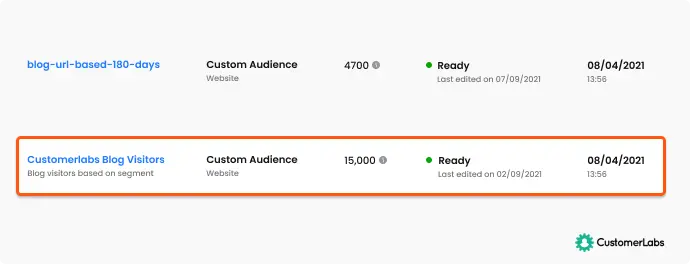
To know more about how Facebook Retargeting Strategies use first-party data, read the blog. – Boost your Facebook Retargeting Ad Campaign performance with First-party data.
First-party data in Advantage+ Shopping Campaigns (A+SC)
Meta’s Advantage+ Shopping Campaigns are driven by AI-powered algorithms that rely on your data to target the audience across all of Meta’s channels.
As Meta recommends, you need to sync your first-party data with Meta Ads through Conversions API to mitigate the audience signal loss.
When you train Meta’s algorithms with first-party data, it optimizes its audience targeting, reaching out to high-intent and high-value customers. Marketers have seen immense results when they leveraged first-party data in Advantage+ Shopping Campaigns. One such result is – 4X conversion rate!
Read more on The Secret to Winning Meta Campaigns: Targeted Conversions with First-Party Data + Smarter AI
Here’s the proof: Meta’s recent update on first-party data
In April 2025, Meta introduced the Meta Signals Gateway, a new infrastructure layer that replaces the older Conversions API Gateway. It enables seamless ingestion, processing, and real-time activation of first-party data from multiple sources—web, app, CRM, POS systems—into Meta Ads and external platforms like BigQuery
From all the above statements and new updates by these ad platforms, one thing stands clear. First-party data is the future.
If you want to kickstart first-party data setup from scratch to feed your marketing channels and ad platforms, schedule a call with our product expert and get started today.

Now let’s get into the benefits of first-party data. (keep reading; next up are use cases of first-party data.)
What are the benefits of First-Party Data (1PD) in a Cookieless World?
1. Understanding Audience Behavior:
When you analyze the first-party data (1PD), you can easily understand the various touchpoints of your customer and how they behaved on your website.
Once you have this data, you can utilize its full potential by segmenting the users based on their similar behavior and run ads.
In the meantime – Explore the Power of Behavioral Retargeting.
2. Predicting the User Behavior:
First-party data helps you understand, analyze and come up with a pattern for user behavior. Now, when you closely observe the data, you can predict the most probable action a user might take in the future.
Understanding the customer journey is only possible when you have access to the accurate user behavior data, i.e., the first-party data.
Read on to learn how to improve your EMQ and reduce ad costs with first-party data
3. Personalization:
Every user has various touchpoints & sources. A customer can come once from a desktop and then later from their mobile phone. When you capture all of this data in one place, you can personalize the users’ experience across all platforms.
When you collect the first-party data using a 1PD Ops like CustomerLabs, you can stitch the entire customer journey to get a 360-degree view of the customer and therefore offer better personalization to the user.
4. Accurate & Reliable Data:
You own the first-party data because you collect the data by yourself. Therefore, you can be sure of the quality of the data. First-party data is the most accurate and reliable data.
Also, the first-party data you collect is in compliance with the data privacy regulations such as the CCPA, GDPR, etc.
5. Nurture the Existing Customers:
First-party data helps you to nurture existing customers by retargeting them with relevant personalized advertisements. Thus, increasing the Lifetime Value (LTV) & Average Order Value (AOV).
6. Perfect Lookalike Audience:
When you send rich first-party data to the ad platform, the algorithm trains itself and comes up with a lookalike audience similar to the custom audience that you submit in the form of first-party data.
So, even to enhance your broad reach campaigns using the lookalike audience, you need to provide better quality first-party data.
Learn how to improve your custom audience match rate with first-party data & Identity resolution
To collect and sync rich first-party data without any audience signal loss, you need a real-time 1PD Ops platform; book a demo today.
Next, let’s take a look at some use cases of first-party data that can take your ROAS and ROI to a whole new level.
What are the Use Cases of First-Party Data?
Here are a few first-party data use cases that we recommended to most of our clients, only to make them see increased growth in their business to move to the next step, the next stage in Digital Maturity.
1. Advanced Audience Segmentation Strategies:
Every business is aware of the basic segmentation strategies and will follow them. And only those businesses that are in the third & fourth stages of the Digitally Maturity Model use advanced audience segmentation strategies by using first-party data.
Some advanced audience segments that businesses use are:
Users who:
- Have visited the page during the last Holiday season sale
- Abandoned the Cart
- Viewed a Certain product/page multiple times
- Have a high AOV (Average Order Value)
- Purchase only when the sale is available
- Make a purchase when there are discounts
Creating more complex and granular segments can be tiring when done manually. With the right tool in place, you will be able to create and use advanced audience segments and create highly personalized experiences for your users.
2. Advanced Event Optimization
With first-party data, you can optimize the ad campaigns beyond the standard purchase event. Creating synthetic or custom events with first-party data Ops platforms such as CustomerLabs is as easy as squeezing a lemon. Here are two synthetic events for your understanding on how you can leverage these synthetic events to optimize the ad campaigns to get your business needs!
AOV-based event optimization
One of the possible purchase event optimizations is—for example—to optimize for purchase events with AOV greater than $1000, or for AOV less than $500, depending on your business strategy.
Category-based event optimization
When a business has multiple categories and syncs the purchase event with Meta, it will see it as a purchase event as a whole but will not understand which purchasers are from which category. To optimize your ad campaigns for a specific category, you must sync the purchases related to that specific category.
For example, suppose you have three categories of products – for newborns, kids, and adults. Now, when you send all your purchase event data with an ad campaign for adults, you might also attract purchasers of newborns. Therefore, it is crucial to optimize your ad campaign with the right purchasers. It is where CustomerLabs 1PD Ops comes into the picture, to utilize your 1P data effectively.
3. Smart Budgeting
Most marketers target only the top & bottom of the funnel by spending 80% of the marketing budget on the top of the funnel (ToFu) and 20% on the bottom of the funnel (BoFu).
With first-party data, you enter into data-driven marketing wherein you can use your middle-funnel audience (MoFu) for retargeting. And we recommend a split of your budget into 60:30:10 for ToFu:MoFu:BoFu respectively.
It is not advisable to increase your BoFu spend beyond 10% of your budget. You can target these Bottom funnel audiences with regular Dynamic Product Ads (DPA) to convert them.
4. Mid-Funnel Strategy
You can micro-segment your middle-funnel audiences into – High-intent, medium-intent, and low-intent.
- High-intent audiences are those who have
- Abandoned the cart in the last 15 days
- Wishlist for more than 30 days
- Viewed the product but not add it to the cart
- Product viewed more than five times
- Medium-intent audiences are those who viewed the product in the last 365 days
- Low-intent audiences are all website visitors who did not perform any major actions as such.
Read on How to Use First-Party Data to Reduce RTO for Shopify
5. Omnichannel Marketing
First-party data collected from various sources gives a detailed picture of a customer journey, which tells how a specific customer navigates from a website to an email to a mobile device and then again back to the desktop before making a purchase.
Now, segmenting based on this behavior helps you optimize your strategies that lead to conversion.
Dundas Life Has Reduced Cost Per Lead by 60% Using First-party Data
6. For Lookalike audiences
Most ad platforms are moving toward automation and AI is doing the job of enhancing & optimizing your ad campaigns for better reach. The only thing you have to do is give as much first-party data with relevant audiences to the ad platform.
The AI trains itself on the data you provide and creates a lookalike audience to help your ads reach the right audiences.
7. Value-Based Lookalike audiences
Value-based lookalike audiences allow you to sync your 1PD with ad platforms along with the value they contribute to your business or with a value that they might contribute. Using the first-party data with value, ad platforms’ algorithms will optimize the campaigns to find the audience that provides high value to your business.
Also read on how value-based lookalike audiences work
Even with multiple use cases and benefits associated with first-party data, why are businesses still up and running on first-party data?
Because they do come up with challenges (that you can absolutely overcome easily). Let’s look at it one by one and will finally reveal a one-stop solution.
What are the Challenges of First-party data (1PD)?
Some challenges that might arise when you decide to use first-party data.
- No proper integration:
With no proper strategy, a business decides to use first-party data just because everyone is hyping it. And they expect it to work instantly. Before even stepping into first-party data, you need to come up with a proper strategy. You should integrate all the sources of data you currently have with tools such as a 1PD Ops platform to overcome the challenge of integration.
- No Real-time tracking:
Most businesses are collecting the first-party data in their servers and then later syncing it with ad platforms. One thing they forget to realize is that delayed data is equal to no quality data. Only when you have real-time data can you analyze and act upon it at the right time before the opportunity window closes.
- Lack of technological advancement:
Marketers I have interacted with have mostly suggested that they lack the technology to leverage the full power of first-party data. However, one solution most of them see as feasible is the First Party Data Ops platform that helps them go beyond conversion tracking and do more with first-party data.
It’s not an impossible task to overcome these challenges.
How to Overcome the Challenges of First-Party Data?
Time to reveal the one-stop solution where you can cover A-Z of First-Party data.
Solution: First-Party data Ops (1PD Ops) platform
CustomerLabs is the World’s 1st First-Party Data Ops Platform. This platform tracks your user data using server-side 1P domain tracking.
Now you can collect data by integrating, not just with one or two but with multiple sources like your website, CRM, PoS, Data warehouses,Subscription systems, etc. (basically from wherever you want).
Once the data is collected, the platform automatically unifies the data points brought in from different sources and stitches them together to create a 360° user profile. Through this, you’ll be able to view the exact journey of every specific user.
Now you can create precise audience segments based on any identifiers and behavioral patterns, interests and products interacted with. You can pick any segment that best fits your campaign objective.
While you utilize audience segments, you can also sync all the conversion events, including synthetic events, to ad platforms to activate the audience (CustomerLabs has patent) and maximize your ad campaign performance.
Not just that, you can stay compliant with privacy laws like GDPR, CCPA, HIPAA; while doing all these. Especially if you are a health and wellness brand, the 1PD Ops platform can automatically filter out sensitive data from the events and hash personal identifiers with SHA256.
If you are an health and wellness brand suffering from ad account blocked or event restrictons, here the solution
Along with that, you can also manage user consent in real time and send it across to ad platforms along with user data.
And if you are smart, the possibilities with 1PD Ops are several.
Conclusion
Therefore, first-party data is the only savior that helps you save your ad campaigns from declining performance. It is much needed for you to act now and collect your first-party data.
It is no secret that every brand has a huge mine of first-party data but is unable to harness and leverage its power.
By collecting first-party data using 1PD Ops, you can scale the entire system to meet your business needs and leverage the complete power of your first-party data.
You, as a marketer, can analyze customer behavior across various platforms, combine them in one place, and craft strategies for all your future marketing campaigns with first-party data.
Be wise and choose first-party data to step with success into the future of digital marketing and unleash the beast.
Want to get started? Talk to our experts today by scheduling a personalized demo here!
